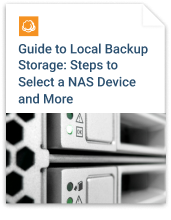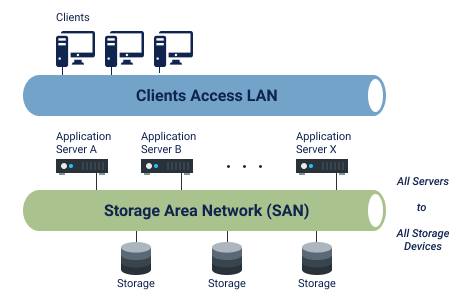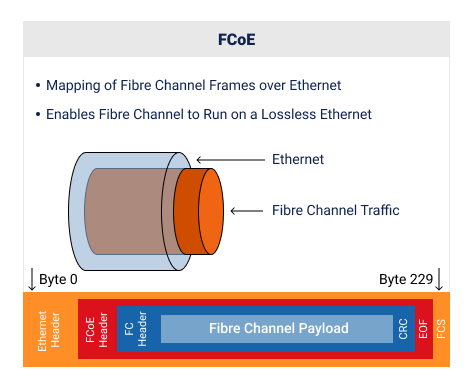A SAN (Storage Area Network) is one of the key infrastructural technologies in data storage and there are varying implementations and standards common for different business use-cases. In this article, we review the key differences between FC, FCoE and iSCSI in order to help you choose the best option.
Storage area network is a block-level solution that is used by storage devices and their clients (application/database/web servers, etc). SAN operates with data blocks, so it is a lower-level solution than shared network storage which provides a number of upsides. SAN is extremely durable and fast due to low data transfer latencies and a focus on guaranteed data block delivery.
The term “block-level” can be explained by comparison with a USB drive.Your PC accesses it using block-level protocols via cables as a transport “network.”
These blocks are a portion of binary data allocated onto the storage. In the case of a USB drive, it is a simple data block. SAN, in turn, contains data blocks of different volumes distributed between hard drives.
Operating systems combine these blocks into a usable data volume, with file systems and files/folders.
SAN networks are built with fault-tolerance and performance in mind:
- Support for simple multipathing.
- Block-level data access and reliable transfers for use with high-availability clusters.
- Higher processing rate allows deploying systems with high input/output needs.
- Network and hardware operate disjunctively, thus enabling better server performance.
Key SAN-related technologies include:
- Fibre Channel (FC)
- FC over Ethernet (FCoE)
- iSCSI
Below is an overview of each.


Fibre Channel
Fibre Channel is the “classic” way to build a SAN network. Here are it’s main technologies and protocols:
- Fibre Channel Protocol (FCP) - data transfer protocol that lets through SCSI commands.
- Fibre optic infrastructure - data transmission tool that is paired with FC devices.
- Name Service - a database for connected devices. It is quite similar to a domain name system (DNS).
- Set of flow control services.
The picture below illustrates a storage network separated from the main LAN:

Basically, “FC SAN” consists of hardware and switches connected by fiber optics. As the network is developed for high-loaded storage devices, it uses a strong cyclic redundancy check (CRC) — a hash function used to produce a checksum in order to detect errors in data. The network also has fewer retransmissions compared to TCP/IP and connection retries due to the loss of data. Typical Fibre Channel speeds are 8Gbps, 16Gbps, and 32Gbps.
Fibre channel is more isolated, as compared with TCP-IP based networks, thus minimizing security issues, malware aftermaths and human errors.
To avoid purchasing special hardware, you can opt for an Ethernet-based network. We’ll explore this in the next section.
Understanding iSCSI
The basic concept of iSCSI is simply putting SCSI commands inside of a typical TCP/IP channel. If you have a regular LAN, you can even install and configure iSCSI Target/Initiator software onto your storage server and its clients, thus facilitating SAN. It allows the same block-level storage access but uses conventional Ethernet networks.
Since underlying networks (TCP/IP over Ethernet) are designed for common usage, there are no strong data flow controls or built-in storage discovery services, that’s why you should set up the majority of settings like IP addresses or LUN visibility manually, and adapt the network for high-volume data by yourself. Additionally, you will need to purchase hardware-accelerated network adapters to offload iSCSI processing from a host server or client.
To implement a high-loaded storage network, you should deploy a dedicated 10Gbps Ethernet-based network (either optical or copper) with hardware-accelerated adapters and network switches supporting larger data frame transfers. In this case, however, you will lose the main benefit of iSCSI — support of existing networks and hardware.
Poor configuration of iSCSI network directly impacts performance, however, it’s hard to detect these issues, as there are several “common” protocols and services involved.
You will also encounter hardware and network settings like Flow Control, Jumbo Frames, Spanning Tree, Trunks, etc. if you choose iSCSI for production.
FCoE vs. iSCSI
There is one more Ethernet-based SAN technology, combining the benefits of both aforementioned options — Fibre Channel over Ethernet. Unlike iSCSI, it does not use the TCP/IP stack and lets FC protocol run inside lossless Ethernet:

FCoE’s major advantage is being isolated while using an assembled network The best examples are “Blade” servers: a rack that packs a lot of special servers in one piece of computing with shared power, network, storage, and management. Using copper Ethernet lanes and switches with the support of FCoE, it allows system administrators to change LAN/SAN distribution depending on business needs, to enhance scalability.
If you’re using high-performance networks (10Gbps or better) and FCoE-enabled switches and adapters, this technology is a good alternative to the classic Fibre Channel (almost the same advantages, with the addition of configuration flexibility through universal transmission layers).
Fibre Channel vs FCoE vs iSCSI: Which is Better for the SAN?
This comparison of Fibre Channel vs FCoE vs iSCSI will help you make your decision:
| FC | FCoE | iSCSI | |
| Allows for use on existing network | - | +/-
(needs special switches and adapters) |
+ |
| Block-level access | + | + | + |
| Strong data flow management
(CRC check, avoids transmission retries) |
+ | + | - |
| Embedded service infrastructure | + | + | - |
| Network isolation by design | + | + | - |
| Need to buy special hardware
(adapters, switches, etc.) |
+ | + | +/-
(good performance impossible without special adapters) |
| Transfer speeds available | 2/4/8/16/32Gbps, support for link aggregation | 1/10/40/100Gbps,
support for link aggregation |
1/10/40/100Gbps,
support for link aggregation |
Conclusion
If you’re running a small company infrastructure or testing environment, choose iSCSI using existing networks and adapters. Gigabit Ethernet is enough for use with non-mission-critical, more demanding applications. But remember to split the logical “storage network” and user LAN to improve performance. (We also suggest, at the very least, enabling Jumbo Frames on all devices involved in storage network transmissions.)
When considering storage implementation solutions for demanding apps, a rapidly growing environment, or use with cluster systems, choose Fibre Channel. This technology is well-known, and most of your concerns will be addressed. When compared to the same zero-point deployment of FCoE, hardware costs are similar.
If dealing with modern converged hardware (e.g. Blade servers), the best choice is FCoE, thanks to its flexibility.





